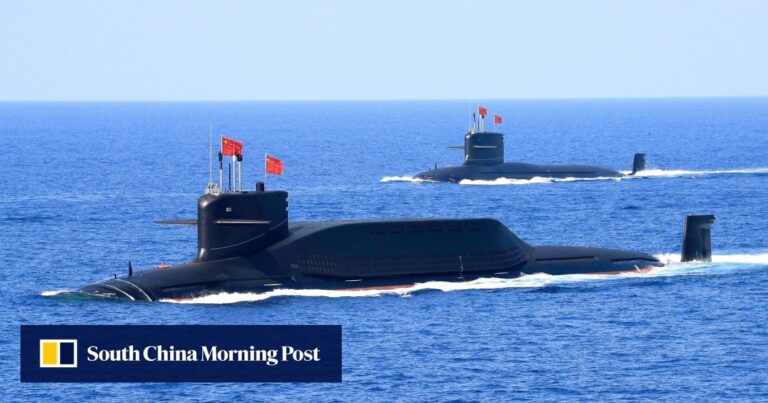Wen said the submarine force had achieved a “historic breakthrough” in torpedo and missile attacks, strengthening its combat capabilities.
“It allows us to reach more remote areas and gives us more confidence in our mission.”
The Chinese government has stepped up efforts to strengthen its strategic defense capabilities and has also ordered the People’s Liberation Army Navy to step up its combat readiness.
Yue Gang, a retired PLA colonel, said the expansion of the submarine force is part of the navy’s efforts to increase its long-range and multi-role combat capabilities.
“Conventional submarines have limited ability to remain submerged at sea for sustained periods. They can only operate in near-shore waters, but nuclear submarines can remain submerged for long periods of time, complementing the PLA’s blue-water forces,” he said.
“Furthermore, future submarines will need to be multipurpose weapons, so they will need powerful propulsion. Conventional submarines will have a hard time meeting that power demand.”
According to the Department of Defense, the PLA Navy has six nuclear-powered Type 094 ballistic missile submarines, including two advanced Type 094As, and six nuclear-powered Type 093 attack submarines.
The Type 094 is capable of firing JL-2 submarine-launched ballistic missiles, which the Pentagon says could reach the continental US when operating from the central Pacific.
The improved Model 094A can carry 16 launch tubes and upgraded JL-2A missiles, potentially capable of reaching the entire U.S. coast from China, according to a report published last year by the Belgium-based defense advisory group, the Army Awareness Group.
A study published last year by the U.S. Naval War College said mounting evidence suggests China’s Type 096 nuclear-powered ballistic missile submarine is likely to become operational by the end of the decade.
According to the university, the new submarine will solve a major problem with China’s nuclear submarines – noise pollution – and will be able to match cutting-edge Russian submarines in terms of stealth, sensors and weapons.
Yue added that only nuclear submarines are capable of catching up with an aircraft carrier at full speed, and developing nuclear submarines can effectively strengthen the PLA Navy’s aircraft carrier fleet.
China has two commissioned aircraft carriers, the Liaoning and the Shandong, and a third, the Fujian, is still in testing.
Song Zhongping, a former PLA instructor, said China’s nuclear-capable submarine force is seen as “a move toward an ocean-going strategic navy that makes extensive use of aircraft carrier formations” and represents “a major shift in China’s naval strategy.”
“It is inevitable that we need to strengthen our nuclear and naval forces. The international situation is changing rapidly, making it all the more necessary for us to enhance our self-esteem and security capabilities,” Song said.
The strategic shift comes as China faces a deteriorating maritime security situation, particularly in the Taiwan Strait and South China Sea, and potential conflict with nuclear-powered navies such as the United States.
China’s sweeping territorial claims in the South China Sea overlap with those of neighboring countries, including the Philippines, which has been embroiled in a series of clashes with the Chinese coast guard over the past year.
Washington has stationed five nuclear submarines in Guam, a territory in the Pacific.
Yue, the former People’s Liberation Army colonel, said this was to “provide nuclear deterrence to the first island chain” that includes Japan, Taiwan and the Philippines.
Both Japan and the Philippines are U.S. treaty allies, and Washington is Taiwan’s largest backer and arms supplier.
U.S. nuclear submarines are known to patrol the South China Sea and the Sea of Japan.
Yue, the former PLA colonel, added that the growing need for nuclear deterrence requires China to develop an effective “dual nuclear” capability – both nuclear submarines and missiles equipped with nuclear warheads.
These “dual nuclear” capabilities were made public in April when the Chinese navy released rare footage of a JL-2 ballistic missile being fired from a Type 094A submarine.
The footage is part of a video showing China’s Shandong aircraft carrier fleet, which includes four submarines, conducting a mock drill at an undisclosed location.
The video was released to mark the 75th anniversary of the founding of the People’s Liberation Army Navy, shortly before U.S. Secretary of State Antony Blinken’s visit to China and just weeks before the inauguration of Taiwan’s new independence-leaning leader, William Lai Ching-te.
Beijing considers Taiwan part of China and should be unified, by force if necessary. The United States, like many other countries, does not recognize Taiwan as an independent country but opposes any attempt to seize the self-governing island by force and has pledged to supply it with weapons.
A People’s Liberation Army Navy nuclear-powered submarine also appeared in the Taiwan Strait on Tuesday, just west of the median line that separates Taiwan from mainland China, about 200 kilometers (120 miles) from Taiwan’s west coast.


